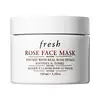What's inside
What's inside
 Key Ingredients
Key Ingredients

 Benefits
Benefits

 Concerns
Concerns

 Ingredients Side-by-side
Ingredients Side-by-side

Water
Skin ConditioningGlycerin
HumectantXanthan Gum
EmulsifyingHibiscus Sabdariffa Flower Extract
Skin ConditioningSodium Citrate
BufferingFragaria Vesca Fruit Extract
AstringentAlthaea Officinalis Root Extract
Skin ConditioningPunica Granatum Pericarp Extract
Skin ConditioningBenzyl Alcohol
PerfumingBenzoic Acid
MaskingDehydroacetic Acid
PreservativeTocopherol
AntioxidantRosa Gallica Flower Powder
Skin ConditioningCitric Acid
BufferingSodium Hyaluronate
HumectantRosa Rubiginosa Seed Oil
EmollientHydrolyzed Hyaluronic Acid
HumectantRosa Damascena Extract
MaskingWater, Glycerin, Xanthan Gum, Hibiscus Sabdariffa Flower Extract, Sodium Citrate, Fragaria Vesca Fruit Extract, Althaea Officinalis Root Extract, Punica Granatum Pericarp Extract, Benzyl Alcohol, Benzoic Acid, Dehydroacetic Acid, Tocopherol, Rosa Gallica Flower Powder, Citric Acid, Sodium Hyaluronate, Rosa Rubiginosa Seed Oil, Hydrolyzed Hyaluronic Acid, Rosa Damascena Extract
Water
Skin ConditioningGlycerin
HumectantButylene Glycol
HumectantPentylene Glycol
Skin ConditioningPolyglyceryl-10 Laurate
Skin Conditioning1,2-Hexanediol
Skin ConditioningRosa Centifolia Flower
MaskingRosa Damascena Flower Water
MaskingRosa Damascena Extract
MaskingAloe Barbadensis Leaf Juice
Skin ConditioningRosa Damascena Flower Extract
MaskingCucumis Sativus Fruit Extract
EmollientRosa Damascena Flower Oil
MaskingCarbomer
Emulsion StabilisingSodium Hydroxide
BufferingCaprylic/Capric Triglyceride
MaskingGlyceryl Acrylate/Acrylic Acid Copolymer
HumectantSodium Hyaluronate
HumectantPropanediol
SolventCaramel
Cosmetic ColorantTrisodium Ethylenediamine Disuccinate
Parfum
MaskingCaprylyl Glycol
EmollientCitric Acid
BufferingSodium Benzoate
MaskingPotassium Sorbate
PreservativeChlorphenesin
AntimicrobialWater, Glycerin, Butylene Glycol, Pentylene Glycol, Polyglyceryl-10 Laurate, 1,2-Hexanediol, Rosa Centifolia Flower, Rosa Damascena Flower Water, Rosa Damascena Extract, Aloe Barbadensis Leaf Juice, Rosa Damascena Flower Extract, Cucumis Sativus Fruit Extract, Rosa Damascena Flower Oil, Carbomer, Sodium Hydroxide, Caprylic/Capric Triglyceride, Glyceryl Acrylate/Acrylic Acid Copolymer, Sodium Hyaluronate, Propanediol, Caramel, Trisodium Ethylenediamine Disuccinate, Parfum, Caprylyl Glycol, Citric Acid, Sodium Benzoate, Potassium Sorbate, Chlorphenesin
Ingredients Explained
These ingredients are found in both products.
Ingredients higher up in an ingredient list are typically present in a larger amount.
Citric Acid is an alpha hydroxy acid (AHA) naturally found in citrus fruits like oranges, lemons, and limes.
Like other AHAs, citric acid can exfoliate skin by breaking down the bonds that hold dead skin cells together. This helps reveal smoother and brighter skin underneath.
However, this exfoliating effect only happens at high concentrations (20%) which can be hard to find in cosmetic products.
Due to this, citric acid is usually included in small amounts as a pH adjuster. This helps keep products slightly more acidic and compatible with skin's natural pH.
In skincare formulas, citric acid can:
While it can provide some skin benefits, research shows lactic acid and glycolic acid are generally more effective and less irritating exfoliants.
Most citric acid used in skincare today is made by fermenting sugars (usually from molasses). This synthetic version is identical to the natural citrus form but easier to stabilize and use in formulations.
Read more about some other popular AHA's here:
Learn more about Citric AcidGlycerin is already naturally found in your skin. It helps moisturize and protect your skin.
A study from 2016 found glycerin to be more effective as a humectant than AHAs and hyaluronic acid.
As a humectant, it helps the skin stay hydrated by pulling moisture to your skin. The low molecular weight of glycerin allows it to pull moisture into the deeper layers of your skin.
Hydrated skin improves your skin barrier; Your skin barrier helps protect against irritants and bacteria.
Glycerin has also been found to have antimicrobial and antiviral properties. Due to these properties, glycerin is often used in wound and burn treatments.
In cosmetics, glycerin is usually derived from plants such as soybean or palm. However, it can also be sourced from animals, such as tallow or animal fat.
This ingredient is organic, colorless, odorless, and non-toxic.
Glycerin is the name for this ingredient in American English. British English uses Glycerol/Glycerine.
Learn more about GlycerinRosa Damascena Extract comes from the Damask rose.
The Damask Roses' petals have been found to help sooth skin. The petals also contain antioxidant compounds.
Rosa Damascena Extract is a tonic. Tonics are used to remove soap residues. They also help moisturize the skin.
Learn more about Rosa Damascena ExtractSodium Hyaluronate is hyaluronic acid's salt form. It is commonly derived from the sodium salt of hyaluronic acid.
Like hyaluronic acid, it is great at holding water and acts as a humectant. This makes it a great skin hydrating ingredient.
Sodium Hyaluronate is naturally occurring in our bodies and is mostly found in eye fluid and joints.
These are some other common types of Hyaluronic Acid:
Learn more about Sodium HyaluronateWater. It's the most common cosmetic ingredient of all. You'll usually see it at the top of ingredient lists, meaning that it makes up the largest part of the product.
So why is it so popular? Water most often acts as a solvent - this means that it helps dissolve other ingredients into the formulation.
You'll also recognize water as that liquid we all need to stay alive. If you see this, drink a glass of water. Stay hydrated!
Learn more about Water